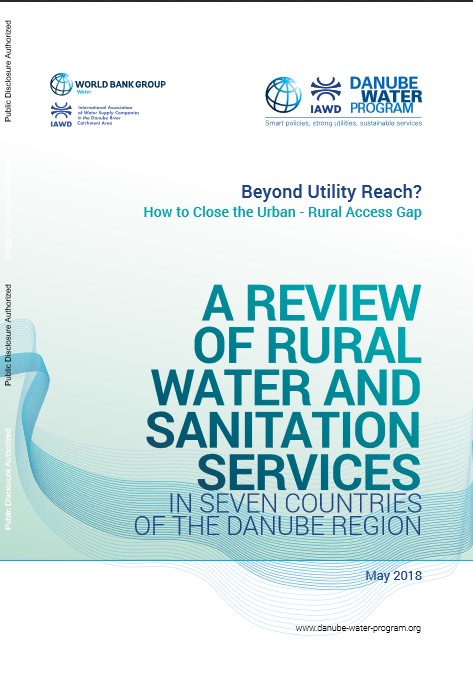Beyond Utility Reach? How to Close the Urban - Rural Access Gap
 |
A review of rural water and sanitation services in seven countries of the danube region
manuel May 2018 ; 144 pages
Ed. World Bank - Washington
Téléchargeable sous format: PdF
Téléchargeable chez l'éditeur
Page de présentation d'un éditeur
Page de présentation d'un autre éditeur
Résumé:
Étant donné que les importantes lacunes en matière d'accès constituent un obstacle majeur à la réalisation des ODD, cette étude de la Banque mondiale a été lancée pour mieux faire connaître l'organisation de la prestation des services ruraux, pour comprendre si et comment l'agrégation par le biais des services régionaux d'eau a effectivement atteint les zones rurales, et pour présenter des leçons et recommandations pour étendre et améliorer la prestation des services aux populations rurales. Sept pays de la région du Danube - l'Albanie, la Bosnie-Herzégovine, la Croatie, le Kosovo, la Moldavie, la Roumanie et l'Ukraine - ont été sélectionnés parce qu'ils représentent un large éventail de résultats en matière d'eau rurale, de défis différents et de contextes de réformes sectorielles Abstract:
Given that the significant access gaps are a major barrier to fulfilling the SDGs, this World Bank study was launched to increase awareness and knowledge on how rural service provision is organized, to understand whether and how the aggregation through regional water utilities has effectively reached rural areas, and to present lessons and recommendations for expanding and improving the provision of services for rural populations. Seven countries of the Danube region —Albania, Bosnia and Herzegovina, Croatia, Kosovo, Moldova, Romania, and Ukraine—were selected because they represent a wide range of rural water outcomes, different challenges, and sector reform contexts Contents:
ACKNOWLEDGMENTS
EXECUTIVE SUMMARY
1.INTRODUCTION
1.1.Objectives and Audience
1.2.Country Selection
1.3.Conceptual Framework and Structure
1.4.Methodology
2.REGIONAL CONTEXT DRIVING URBAN–RURAL ACCESS
2.1.The Urban–Rural Divide
2.2.Political and Socioeconomic Context
2.3.Administrative Context and Decentralization
2.4.EU Accession and Legislation
2.5.Water Resources
2.6.Rural Access and Prevalence of Management Models
3.Country Sector Reforms and the Enabling Environment 3.1.Country-level Sector Reforms
3.2.Assessment of Enabling Environment Conditions
3.2.1.Institutional Capacity and Support
3.2.2.Financing and Affordability
3.2.3.Asset Management
3.2.4.Water Resource Management
3.2.5.Monitoring and Regulatory Oversight
4.Analysis of Rural Water Supply and Sanitation Service Provision
4.1.Understanding Self-Supply
4.1.1.Service Levels and Satisfaction for Self-Suppliers
4.1.2.Barriers to Connect to Piped Water Systems 4.2.Those within Reach: Service Levels and Customer Satisfaction
4.2.1.Accessibility
4.2.2.Reliability and Continuity
4.2.3.Customer Satisfaction
4.3.Water Quality Management
4.3.1.Customer Perceptions of Water Quality
4.3.2.Disinfection and Water Quality Monitoring Practices
4.4.Performance and Capacities for Service Delivery
4.4.1.Business Practices
4.4.2.Commercial and Financial Performance
4.5.Sanitation services
5.Recommendations for Sustainable Services for All625.1.Developing a National Enabling Environment for Universal Access
5.1.1.Realizing the SDGs by Adopting Multiple Service Delivery Models
5.1.2.Developing an Enabling Environment for Rural Water Services
5.1.3.Reaching Poor Households with Rural Water Services
5.2.Improving Delivery Models at Service Provision Level
5.2.1.Regional Utility Model: Lessons and Recommendations
5.2.2.Local Operator Model: Lessons and Recommendations
5.2.3.Supported Self-Supply: Lessons and Recommendations
5.3.Addressing Rural Sanitation
References
Annex A. Methodology
Annex B. Basic Data on Service Authorities and Operators
Annex C. Overview of Administrative Tiers
Annex D. Additional Data Analysis
Annex E Country Overviews8
Mots clefs: |
accès à l'eau (CI) (DT) (OP) (ope) , rural (CI) (DT) (OP) (ope) , urbain (CI) (DT) (OP) (ope) |
Pays concernés: |
Albanie (CI) (DT) (OP) , Bosnie-Herzégovine (CI) (DT) (OP) , Croatie (CI) (DT) (OP) , Kosovo (CI) (DT) (OP) , Moldavie (CI) (DT) (OP) , Roumanie (CI) (DT) (OP) , Ukraine (CI) (DT) (OP) |
Editeur/Diffuseur: |
|
World Bank - Washington - Etats Unis |
En cas de lien brisé, nous le mentionner à communication@pseau.org